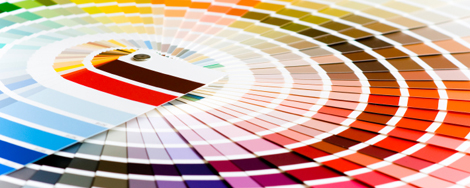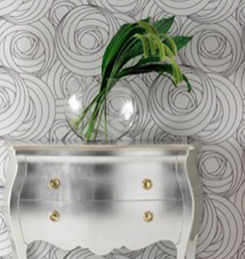
Color symbolism is the use of color to represent traditional, cultural, or religious ideas, concepts, feelings or to evoke physical reactions. Choosing colors based on symbolism or color meanings can apply to everything from clothing to wall paint to home furnishings.
Colors are more than a combination of red and blue or yellow and black. They are non-verbal communication. Colors have symbolism and color meanings that go beyond ink.
Physical and Cultural Color Reactions
Sometimes colors create a physical reaction (red has been shown to raise blood pressure) and at other times it is a cultural reaction (in the U.S. white is for weddings, in some Eastern cultures, white is the color for mourning and funerals). Colors follow trends as well. Avocado, a shade of green, is synomous with the 60s and 70s in the minds of some consumers.
Color Relationships
In addition to understanding color meanings, it helps with mixing and matching colors to know the relationship of adjacent, harmonizing, contrasting, and complementary colors.
Adjacent or harmonizing colors appear next to each other on the color wheel. Harmonizing colors often work well together but if too close in value they can appear washed out or not have enough contrast. A harmonizing trio could be something like blue, light blue, and cyan or perhaps red, orange, and yellow.
Contrasting colors are separated from each other by other colors — they come from different segments of the color wheel. The further apart, the more the contrast. Red (from the warm half of the color wheel) contrasts with green and blue (from the cool half of the color wheel). Shades of purple contrast with shades of green. Contrasting colors that are directly opposite each other on the color wheel may be described as clashing colors — see the description for complementary. Despite the name, colors that clash are not always a bad combination if used carefully. They provide great contrast and high visibility.
Complementary colors are on opposite sides of the color wheel – they are each half of a pair of contrasting colors. For example, blue is a complementary color to yellow. Green is complementary to purple and magenta. A pair of complementary colors printed side by side can sometimes cause visual vibration (clash) making them a less than desirable combination. However, separate them on the page with other colors and they can work together. Note the spelling. These are not complimentary colors. They don’t always flatter (compliment) one another but they do complete (complement) each other.
On each of the cool, warm, mixed, and neutral pages are links to profiles of specific groups of colors with descriptions of their nature, cultural color meanings, how to use each color in design work, and which colors work best together. Visit the website and learn more about colors and their meanings.
Info/: About.com
Article in Norwegian
Ton-i-ton
Tar utgangspunkt i en enkelt kulør, valgt fra bare ett punkt på fargesirkelen. Fargen brukes i mange nyanser: kulørsterk og nedtonet, dempet mot hvitt og mot grått. Resultatet blir et rolig og harmonisk interiør med et elegant og behersket uttrykk. Det er en oppskrift som er trygg å arbeide med for den som føler seg usikker på å kombinere flere kulører. Likevel ligger det rike variasjonsmuligheter i denne begrensningens kunst. Litt hvitt og/ eller sort kan gjerne settes til for å stramme opp og skape kontrast.
Nabofarger
Nabofarger hører hjemme nær hverandre på fargesirkelen. De kler hverandre godt og er lette å kombinere. Velger du kulører innen samme kvartal på fargesirkelen kan du skape vakre fargeharmonier, med fin samklang. Med kraftige kulører står nyansene dristig mot hverandre og kan være krevende å få til. Med dempede toner blir det heller harmonisk og behagelig. Jo mindre sprang det er mellom kulørene på fargesirkelen desto tryggere og mer forsiktig blir resultatet og kombinasjonene. Jo større sprang, desto mer spenning oppstår det mellom dem.
Komplementærfarger
Komplementærfarger er hverandres rake motsetning. Egentlig er de hverandres ”etterbilde” på netthinnen. Stirr lenge på noe grønt, lukk øynene og du ser rødt. På samme måte vil oransje danne etterbildet til blått og lilla til gult. Fargene fremhever hverandre flott, eller de konkurrerer med hverandre. Det grønne virker grønnere med en detalj i knallrosa. Det blå blir enda mer blått med en dristig dash oransje i nærheten.
Verdt å vite
Komplementærfarger satt opp mot hverandre kan virke vibrerende for øyet. Derfor må de brukes med en viss forsiktighet, i hvertfall om kulørene er kraftige. Det er viktig å velge én som hovedfarge og la den andre være krydder. Fra tegnetimen husker du kanskje at komplementærer ligger tvers overfor hverandre på fargesirkelen. Men det er på en sirkel der bare gult, rødt og blått er fordelt som grunnfarger. På NCS-systemets sirkel, som opererer med grønt i tillegg, ligger komplementærene noe annerledes.
Natural Color System®
Aktørene i fargebransjen har ett felles språk, NCS, (Natural Color System®). Ved hjelp av det kan fargene uttrykkes med en enkel formel satt sammen av tall og bokstaver, og enhver misforståelse er ryddet av veien. NCS-systemet ser enhver farge som en blanding av tre begreper, kulørthet, hvithet og sorthet. Når kulørtheten dominerer, er fargene kraftige og intense. Dominerer hvitheten, er de lyse og lette, dominerer sortheten, er de dunkle og dype. Koden som uttrykker fargen består av to ledd: det første uttrykker blandingsforholdet mellom kulør og sort/hvitt, det andre forteller hvilken kulør det handler om.
Kilde, Norway: IFI, Informasjonskontoret for farge og interiør



